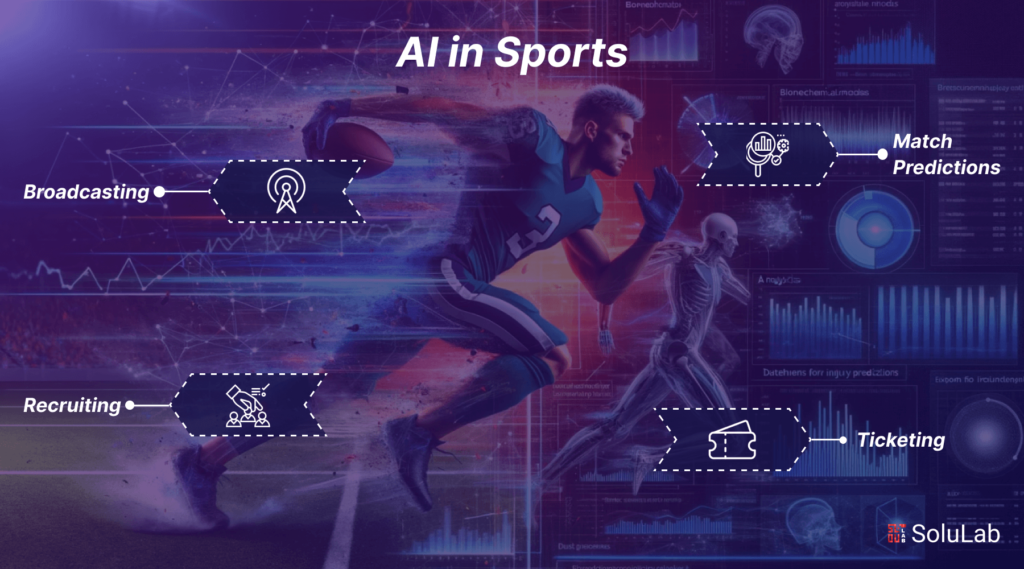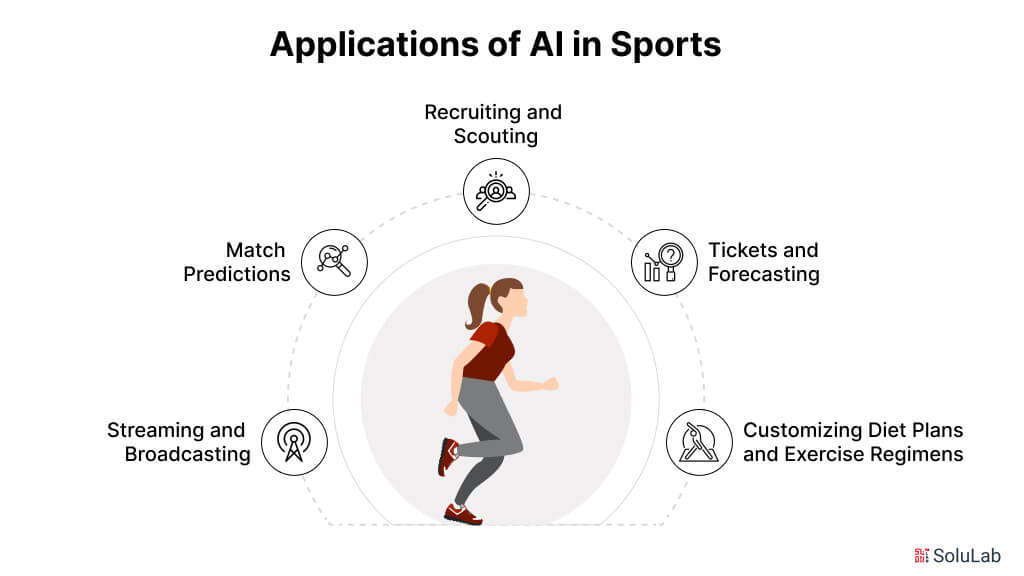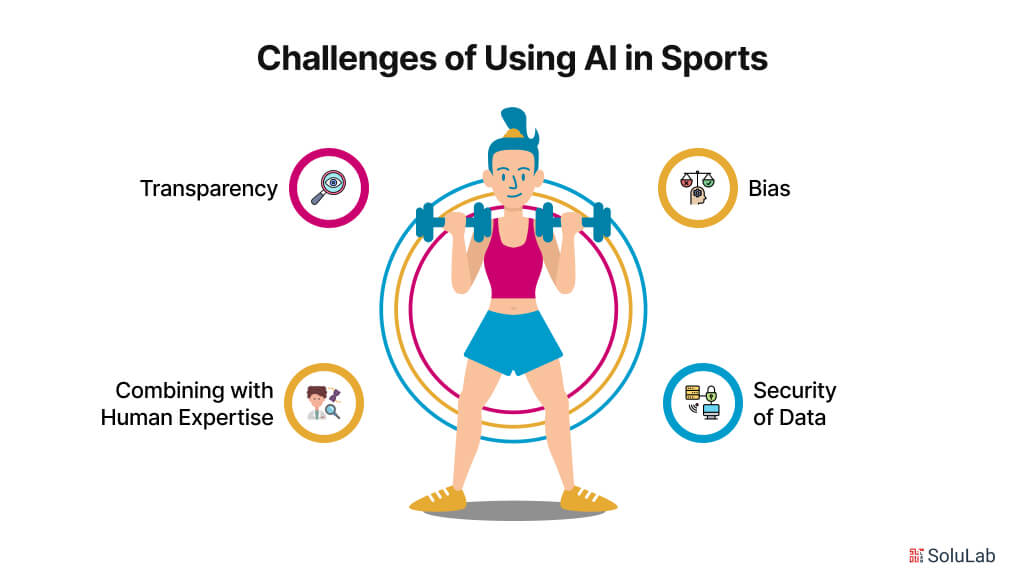
Artificial intelligence has drastically changed the way how we usually watch and analyze sports during the last 20 years. AI and machine learning in sports are improving the game for players, broadcasters, sponsors, and finally the spectators who can access the real-time data. Moreover, one of the main advantages of AI in sports is forecasting its crucial role in enabling informed decisions. The global sports analytics market is projected to reach a valuation of 22 billion dollars by 2030.
AI in sports is sure to have a bright future of AI in sports because of the accuracy and good effects this technology brings to the table. This blog will discuss how artificial intelligence (AI) is being used and applied in the sports industry, how AI is transforming the sports business, and the challenges it may face during its implementation.
What is AI in Sports?
Artificial intelligence in the sports industry has gained rapid traction in several industries, including sports. Artificial intelligence (AI) technology is changing traditional administrative activities as well as how teams prepare, compete, and connect with supporters. Similar predictions are also made by allied market research, which illustrates how pervasive artificial intelligence has grown in the world of sports. The use of AI in sports demonstrates how important AI has become in the context of sporting events.
Sports events have always been dynamic and show examples of AI in sports where a one-second decision results in a complete turnaround of the game. Therefore real-time data processing systems are very vital in this regard. The invention of AI can directly be related to its ability to analyze volumes of data in the shortest time with extreme precision, a task often found daunting by human analysts due to the volume or complexity issues.
How is AI Being Used in Sports Analytics Today?
AI isn’t just used to look at data anymore; it’s a strategy tool that helps teams beat their rivals, improve player health and performance, and rethink what it means to be a fan.
1. AI-Driven Training Program
In the past, athletes counted on their coaches’ knowledge to improve their performance. Now, AI is taking it to a whole new level. A lot of information about athletes’ running speeds, endurance levels, and even reaction times is collected during training games. An AI system can handle all of this information. So, by looking at these measures, AI creates personalized training plans for each athlete that focus on his weaknesses and make the most of his strengths.
For example, a sprinter might want to work on speeding up over the first few meters, but in hoops, you need to do drills that improve your agility and sense of space. This kind of subtlety can be picked up by AI software faster and more accurately than by a human teacher. This way, athletes can reach their full potential without overworking themselves or getting hurt.
2. Fatigue and Stress Monitoring
In professional sports, injuries happen all the time. One of the most exciting uses of AI is to find and stop injuries before they happen. As a person moves their joints and strains their muscles, a team can use AI algorithms to keep track of their biomechanics. It can look for trends or oddities that point to an injury before the symptoms show up.
For instance, an AI could notice a small difference in how much stress a soccer player puts on a knee joint and let the coaches or medical staff know about it. The team could then do exercises to help the person get better or let them rest long before they got hurt badly enough to have to miss games. AI keeps track of how well healing is going and can tell you what changes need to be made to a training plan.
3. Keeping an Eye on Stress and Fatigue
Fatigue and worry can have a big effect on athletic performance. At crucial times, players may not be as effective on the field and there is a high risk of injury. AI sensors built into wearable tech can constantly check an athlete’s heart rate, oxygen levels, muscle strain, and even stress hormones. AI systems use this information to figure out when a player is getting close to being physically or mentally worn out. This helps teams change how hard they train or how many games they play in.
This proactive method helps the teams keep track of their players’ workloads so that they don’t get too tired and they can perform at their best during important events like tournaments and playoffs.
Data-Driven Game Analytics
AI gives real-time information about how the game is changing, which helps them make smart choices and improves their chances of winning.
1. Analysis of Games in Real-time
In professional sports, you have less than a second to make a choice. During a game, the AI systems use real-time data to keep track of where players are, where the ball is, who has it, and how far away they are from the goal. Cameras record every move, and AI can process that data in real time to help teachers figure out how to change their strategies. AI might notice that there is a player in a basketball game who always gets good looks from the outside. This can then be given to the coach, who can change how the defense plays. On the other hand, share this information with the attacking team so they can use it to their advantage even more.
2. Advanced Metrics to Assess Players and Teams
AI can keep track of a lot more than just goals, assists, and saves. AI’s more advanced metrics give us a deep look into how AI is currently being used in sports data. In soccer, AI might keep track of not only how many times a player hits the ball, but also how well they touch it, how far they run at high speed, and how much they help the defense. These more advanced metrics will help coaches and analysts look at actions in more depth and find strengths and weaknesses that might not have been as clear with older statistics. This level of in-depth analysis is important for coming up with game plans, which makes it clear how AI is being used in sports analytics today. Also, about making smart choices about when to rotate players or make changes.
3. Game Outcome Prediction
The ability to guess what will happen is one of the most exciting ways that AI is used in sports. We can pretty accurately guess how a game will turn out by looking at a lot of things, such as past success, the weather, and even mental state. Fans and sports betting companies aren’t the only ones who can use this. Teams also use it to figure out how to better plan for their opponents. AI might know that a football team will be most tired and less competitive in the fourth quarter because that’s when they’ve been tired in the past. The other team can then use this weakness to change their plan. AI makes guesses that help teams stay ahead of the other teams, which gives them an edge.
Factors Driving the Sports AI Market Growth
The following are some of the many positive aspects that are driving AI’s expansion in the sports sector.
- An increase in the demand for player observation and tracking
- There is a growing need for real-time data analytics.
- Growing need for AI-powered sports forecasts and predictions
- Virtual assistants and chatbots are required to interact with sports enthusiasts.
- Using mobile apps like ESPN, HomeCourt, SmartCoach, and others provides a convenient method to watch sporting events and improves player training.
Applications of AI in Sports

With the establishment of artificial intelligence in sports and thorough data analysis the coaches, teams, players, and fans have the right opportunity to grow and share how it is impacting the industry. Here are the top applications of AI in sports :
1. Streaming and Broadcasting
AI applications in sports can easily boot streaming and broadcasting experiences and functions. Even though a lot of the population is already enjoying going to the stadiums, arenas, and the field where the sport is being played, the majority of spectators still watch and listen on television or radio. Sports broadcasting firms strive to offer exceptional coverage, which includes high-quality photography, transmission, commentary, and intriguing visuals depending on audience preferences and statistics to stay ahead of the competition. AI is used to raise the caliber of streaming and broadcasting to assist with this.
2. Match Predictions
An AI system can handle far more data than a human can, and it can’t forecast every match with precision, AI use cases can come considerably much closer than a human could when making match predictions. When it comes to football, computer vision technology is especially useful since it can be used to gather and analyze data based on:
- The number of passes made by teammates
- The establishment of a team
- The total number of goals scored
- Opportunities Generated
- Key moves that can lead to goalkeeping
Making use of this data, AI and sports together can predict if a team will win, or lose, or if there is a possibility of a draw match.
3. Recruiting and Scouting
Any noteworthy event that occurs during a game in any sport is monitored by the team and its players, generating a lot of data. A player can be tracked using computer vision, giving recruiters, valuable information about how well the player is performing. They can be confident that they are bringing in players who will succeed for the team and who they can potentially acquire at a low cost, develop, and then sell for profit later on thanks to AI.
4. Tickets and Forecasting
With AI for sports, there are innumerable instances of sports where supporters have struggled to enter stadiums in time for games due to delays and problems with their tickets. The sports team Columbus Crew has implemented face recognition technology to allow its supporters to enter the stadium without showing their tickets, resulting in a more efficient ingress and the avoidance of congestion. This is especially significant since it shortens lines for those who are more cautious in the post-pandemic environment.
5. Customizing Diet Plans and Exercise Regimens
Coaches are constantly searching for new methods to enhance training regimens and dietary programs to maintain athletes at the highest level of performance. Artificial intelligence sports have already demonstrated encouraging results in weight training, demonstrating the viability and effectiveness of AI techniques in automatically evaluating progress using weights and equipment training and promptly advising athletes. Machine learning and artificial intelligence are used to customize eating plans for various athletes according to their circumstances and needs.
How is AI Building Fan Engagement?
Any sports fans be it racing, tennis, football, and cricket all yearn for participation. Whether a racing team principal is debating a tire change or a football manager is choosing their next replacement, fans long for a chance to voice their opinions. Prominent competitions and leagues are utilizing AI in the gaming industry to offer comprehensive real-time player performance data and match insights, thereby bringing fans much closer to decisions that coaches might take. Fans are getting better viewing experiences as a result of the technology adoption and integration in sports. Viewers also have the opportunity to learn from the comfort of their homes.
AI systems enable sports organizations to provide fans with more individualized experiences and recommendations. If a venue does not live up to fan expectations, the excitement of being at a live sports match or event can quickly wear off. For this reason, to improve the entire spectator experience, stadiums are starting to adopt AI-driven technologies. Fans are devoted, passionate, and driven having a strong desire for sports-related goods and services.
AI can analyze enormous volumes of data to find trends, anomalies, and new forms of fraud since it is educated on billions of worldwide transactions and advantages globally effect. Moreover, tournament ticket sales and advanced analytics can offer distinct, current insights into customer behavior, and purchase history. When used well, AI improves the fan experience with guaranteed safety during live events and customizing interactions.
How Do Wearable AI Devices Work?
Though a lot of raw data is produced by wearables, meaningful insights are created with AI integration. This massive volume of data may be processed and interpreted by AI algorithms, which can also uncover insights, connections, and hidden patterns that humans might overlook. This partnership between data gathering and AI analysis demonstrates how AI is transforming sports.
1. Traditional Wearables
Wearable technology such as fitness trackers and smartwatches, has become essential for monitoring many of the parameters mentioned above. The speed, location, total distance traveled, and the pattern of movements of an athlete can all be tracked by wearable GPS devices. When used in conjunction with accelerometers that track velocity change rates in several directions, they provide relevant information.
Wearable heart rate monitors use optical sensors to detect blood flow allowing for real-time heart rate tracking. This is quite crucial for tracking heart health, intensity of workouts, and healing. It also assists with monitoring the saturation of oxygen in the blood yet another essential part of contemporary fitness trackers. They evaluate the blood’s oxygen saturation level using optical sensors.
2. Prolonged Wearables
For professional sports, Inertial Measurement Units (IMUs) such as GPS tracking vests have grown more common since the 2010s. These vests, which include sensors on the upper back are often worn as tank tops and offer discreet and efficient GPS tracking. These vests are mostly used in sports such as rugby and soccer for tracking the player’s movement and location, providing information about a players’ strengths and areas for development. Training schedules, player substitutions, and strategic planning are all aided by this data. During practice and competition, these gadgets monitor all the positions, lengths, rates, accelerations, and heart rates of athletes.
Impact of AI on Sports and Equipment
Artificial intelligence for sports has already greatly impacted the industry and the trend is predicted to continue in the other areas, of the business. AI has become widely used in the recent adoption of OpenAI’s ChatGPT. The world of AI was not widely used or understood a year ago. As layman says Artificial intelligence is machine learning technology, such as a computer program, that replicates human intelligence to learn and perform tasks even more intelligently. Here are some examples of how artificial intelligence is already impacting the sports sector and how it could transform it in the future:
-
Evaluation of Performance
Coaches and players can examine enormous volumes of data regarding activities, rivals, and individual performances with the aid of AI systems. Real-time decision-making strategy development and strength and weakness analysis are all possible with the utilization of this data.
-
Avoidance of Injury
AI is also shown to be quite helpful in preventing injuries and any other possible health-related issues. Artificial intelligence uses biometric data, athletic medical histories, and injury trends to estimate the risk of injuries and assist teams in taking preventative action. For any athlete to remain competitive it is important to keep recognizing any shortcomings and what steps should be taken to avoid them.
-
Game Research and Planning
Algorithms that use AI are essential for team analysis and researching about the opponent this will lead to successful tactics by teams. Coaches get access to real-time insight before and even during the matches which helps them with in-game decisions based on the performances given by the players and according to the present situation. Using predictive analysis, AI helps teams select the best starting lineups and backup plans as well.
-
Optimization of Training
Making use of apps like Athletica AI, coaches are redefining player instructions that are based on exercise data gathered from various sports apps, like Nike Run Club and Strava. The majority of sports fans are being encouraged by this to join the trend and adopt flexible exercise regimes. Another impact of AI is enhancing player training with virtual reality simulations, which may simulate game situations. Athletes can be ready to make decisions about their sport in a variety of situations.
Benefits of AI in Sports
Artificial intelligence is changing the sports business industry by transforming the way athletes are trained, perform, and interact with spectators. AI improves athletic performance and safety while giving teams a tactical edge by utilizing data analytics, machine learning, and real-time feedback. With the use of AI, coaches can analyze enormous volumes of performance data, resulting in better-informed decisions and training plans customized as per the demands and needs of players.
Furthermore, by building more immersive and engaging environments, AI is changing the fan experience. Fans can now watch and enjoy in real-time at the same time obtain insights and data with greater engagement thanks to developments in virtual reality and augmented reality. AI’s influence on sports is providing many benefits as it develops, opening the door for creative solutions that improve player performance and spectator interaction. Here are the major benefits of AI in sports you can’t miss:
- AI offers in-depth perceptions of players’ performances allowing for extracting modifications and enhancements to training plans.
- Identification of possible risks can be managed with the implementation of AI in sports by proper examination of movement patterns.
- According to opponent performance and behavior trends, coaches can create more effective game plans by leveraging AI-driven statistics.
- AI streamlines the variety of administrative and analytical tasks, which in return frees up teams to concentrate on important areas of growth.
Diverse Use Cases of AI in Sports
Artificial Intelligence (AI) has seamlessly woven itself into the fabric of the sports industry, offering a plethora of innovative solutions across various domains. The following use cases exemplify the versatility and transformative potential of AI in sports:
Performance Analysis
- Player Metrics: AI-powered tools analyze player data, including movement patterns, speed, and stamina. This aids coaches in tailoring training regimens to optimize individual and team performance.
- Injury Prevention: Predictive analytics, combined with wearable technology, allows for real-time monitoring of athletes’ physical conditions, enabling the early detection of potential injuries and the implementation of preventive measures.
Game Strategy Enhancement
- Opponent Analysis: AI algorithms sift through vast amounts of historical and real-time data to analyze opponents’ strategies, strengths, and weaknesses. Coaches can then formulate game plans tailored to exploit the opposition’s vulnerabilities.
- Tactical Insights: AI assists in dissecting game footage, providing coaches with valuable insights into player positioning, decision-making, and strategic execution.
Fan Engagement
- Personalized Experiences: AI algorithms analyze fan preferences and behaviors, enabling sports organizations to deliver personalized content, such as targeted promotions, merchandise recommendations, and interactive experiences, enhancing fan engagement.
Referee Decision Support
- Video Assistant Referee (VAR): AI-powered video analysis aids referees in making accurate and fair decisions during matches. VAR systems help review contentious situations, reducing human errors and ensuring a higher level of officiating accuracy.
Athlete Training and Development
- Skill Enhancement: AI-driven simulations and virtual training platforms allow athletes to hone their skills in a controlled environment. This facilitates targeted training for specific scenarios, contributing to skill development.
- Biomechanical Analysis: AI technologies, including computer vision, analyze athletes’ movements, providing detailed insights into biomechanics. This information is invaluable for refining techniques and preventing injuries.
Data-driven Recruitment
- Scouting and Drafting: AI algorithms analyze extensive datasets to identify promising talent. Sports organizations leverage predictive analytics to make informed decisions during player recruitment, scouting, and drafting processes.
Health and Wellness Monitoring
- Nutritional Planning: AI assists in creating personalized nutrition plans based on individual player requirements, considering factors like metabolism and training intensity.
- Recovery Optimization: By analyzing sleep patterns, stress levels, and recovery data, AI contributes to optimizing athletes’ recovery routines, ensuring peak physical condition.
These use cases underscore the transformative impact of AI in sports, reshaping how teams train, strategize, and engage with their fans, ultimately elevating the overall sports experience.
Challenges of Using AI in Sports

It has become crucial to take into account the possible ethical conundrums that can surface as artificial intelligence becomes more widely used, in addition to the extremely essential machine learning tactics used in the sports sector. Concerns about possible bias, data accuracy, and privacy are just a few of these considerations. As every athlete does not have access to statistics and training tools driven by AI, their progress might not be the same as those who do. Here are the major challenges posed by the implementation of AI in sports:
1. Combining with Human Expertise
Artificial Intelligence in sports can offer insightful analysis but it’s more important to properly combine such technology with human knowledge. A coach, player, or other sports practitioner may possess this knowledge and intuition which AI may not be able to communicate. It is quite difficult to strike a balance between AI and humans.
2. Transparency
Many large language models, especially the ones with deep learning algorithms are viewed as “black boxes” since it is impossible to follow the reasoning behind any particular judgment and prediction. The primary barrier to the adoption of AI systems in sports is their lack of interpretability and transparency, particularly when it comes to tactical or punitive actions that have grave consequences.
Related: Comparison of Large Language Models
3. Bias
If the training data for the system isn’t exclusive to a diverse variety of athletes. AI may inadvertently promote preconceived notions or limitations, thus ensuring data accuracy and variation is pivotal during the deployment of AI. An AI model that performs well when collecting training data but struggles to generalize new players with different game schemes is known as overfitting.
4. Security of Data
The collection of data can be invasive and make the players concerned about how their data will be shared and used. For instance, when you gather information about an athlete’s physical powers, AI systems may disclose private information that the athlete may not wish to reveal. Additionally, inadequate data security and storage can result in identity theft and other data breaches harmful to information.
Future of AI in Sports
Teams and coaches will later be able to develop more successful plans by evaluating opponent data and making tactical modifications in real-time as top AI development companies become even more sophisticated and precise in their prediction as data collection grows. With the proper use of fingerprints, past events, and external factors, advanced predictive models will be able to foresee any possible incidents with extra accuracy.
In addition to providing amusement, sports also foster team building and, of course, business. With artificial intelligence (AI) in sports emerging as a valuable asset, all eyes are on the future. By 2030, the artificial intelligence industry is expected to grow rapidly, reaching a value of US $19.2 billion. Additionally, there is a ton of potential that suggests a future breakthrough.
Thanks to artificial intelligence and sports, we are living in a time where robots report games and redefine media presence. Media outlets may now cover stories using AI without having to physically go to the area and set up cameras. By using artificial intelligence (AI) to relay every minute of ongoing play on the field, content dissemination will soar to boost audience engagement.
The player and the team as a whole will be able to predict the opponent’s next move thanks to data-driven information sharing, which will improve strategy development. VR and AR are about to have an incredible explosion. By 2031, it is expected that the worldwide VR industry for sports and entertainment will have grown to $56.7 billion. Sports teams in the NFL and NBA, as well as sports networks like ESPN, are all utilizing AR and VR to increase fan interaction and provide a strong example of AI in sports.
How Can SoluLab Help You Build An AI-Driven Application?
Given that AI is influencing patterns across a variety of industries, it will be interesting to watch how sports are affected going forward. We may be prepared to see the possibilities for wearables, quick match highlights, chatbots, and other such innovations to bring forth further advancements in sports as we are used to them.
As organizations seek to harness the power of AI in sports, partnering with experienced developers becomes paramount. SoluLab stands out as a leading force in AI development services, offering tailored solutions to meet the unique needs of the sports industry. With a proven track record in implementing modern AI technologies, SoluLab empowers sports organizations to leverage data-driven insights, enhance player performance, and deliver unparalleled fan experiences. Whether it’s implementing predictive analytics for injury prevention or creating immersive virtual training platforms, SoluLab’s expertise ensures that the potential of AI in sports is fully realized, propelling the industry into a future where innovation knows no bounds.
Are you ready to use AI applications and technology for your business not alone for growth and development but also for stepping up in creation? Contact us today!
FAQs
1. How does AI contribute to player performance enhancement in sports?
AI plays a pivotal role in player performance by analyzing data such as movement patterns, speed, and stamina. This information is used to tailor training regimens, optimize individual and team performance, and prevent potential injuries through real-time monitoring with wearable technology.
2. What is the significance of AI in refining game strategies in sports?
AI provides coaches with valuable insights into opponents’ strategies, strengths, and weaknesses through the analysis of vast amounts of historical and real-time data. This enables coaches to formulate game plans that exploit the opposition’s vulnerabilities and make informed decisions during matches.
3. How does AI contribute to fan engagement in the sports industry?
AI in the sports industry enhances fan engagement by analyzing fan preferences and behaviors. This allows sports organizations to deliver personalized content, including targeted promotions, merchandise recommendations, and interactive experiences, creating a more engaging and tailored experience for fans.
4. Can AI help in officiating accuracy in sports events?
Yes, AI significantly contributes to officiating accuracy through technologies like Video Assistant Referee (VAR). These AI-powered systems assist referees in reviewing contentious situations, reducing human errors, and ensuring fair and accurate decisions during matches.
5. In what ways does AI contribute to athlete training and development?
AI-driven simulations and virtual training platforms enable athletes to hone their skills in controlled environments. Additionally, AI technologies, including computer vision, analyze biomechanics to provide detailed insights for refining techniques and preventing injuries, contributing to overall athlete development.
6. How does SoluLab ensure the success of AI projects in the sports industry?
SoluLab ensures the success of AI projects in the sports industry through its expertise in AI development services. The company leverages its proven track record to deliver tailored solutions that meet the unique needs of sports organizations. From implementing predictive analytics for injury prevention to creating immersive virtual training platforms, SoluLab’s commitment to excellence empowers clients to fully harness the potential of AI in sports, leading to enhanced player performance and unparalleled fan experiences.






